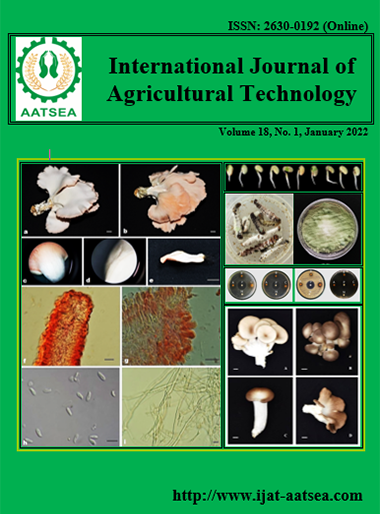Study on different concentrations and timings of 17α-methyltestosterone to accumulate in water flea (Moina spp.) from lab-scale
Main Article Content
Abstract
The different concentrations and immersion times of 17α-methyltestosterone (17MT) on the accumulation in water flea were investigated. Results were found that amount of 17MT of both groups in each period displayed significantly different (P <0.05) when compared to the control. The highest accumulation of 17MT was found at the concentration of 100 mg / L for 420 minutes equal to 0.46 ± 0.10 mg/L. In contrast, it was found that the amount of 17MT in both concentrations of water at three times was not statistically significant (P> 0.05)in each treatment. Therefore, results indicated that the accumulation of 17MT in water fleas can be applied for using accumulated water flea to produce male tilapia
Article Details

This work is licensed under a Creative Commons Attribution-NonCommercial-NoDerivatives 4.0 International License.
References
Beardmore, A., Mair, G. C. and Lewis, R. I. (2001). Monosex male production in finfish as exemplified by tilapia: Applications, problems, and prospects. Aquaculture, 197:283-301.
Barbosa, I. R., Lopes, S., Oliveira, R., Domingues, I., Soares, A. M. and Nogueira, A. J. (2013). Determination of 17α-methyl testosterone in freshwater samples of tilapia farming by high performance liquid chromatography. American Journal of Analytical Chemistry, 4:207.
Celik, I., Guner, Y. and Celik, P. (2011). Effect of orally-administered 17α-Methyl testosterone at different doses on the sex reversal of the Nile tilapia (Oreochromis niloticus, Linnaeus. 1758). Journal of Animal and Veterinary Advances, 10:853-857.
Dergal, N. B., Scippo, M-L., Degand, G., Gennotte, V., Mélard, C., Sidi-Mohammed Abi-Ayad, El-A. (2016). Monitoring of 17α-methyltestosterone residues in tilapia’s (Oreochromis niloticus) flesh and experimental water after its sex reversal. International Journal of Biosciences, 9:101-113.
Fitzpatrick, M. S. and Contreras-Sánchez, W. C. (2000). Fate of methyltestosterone in the pond environment: Detection of MT in soil after treatment with MT food. In: K. McElwee, D. Burke, M. Niles, X. Cummings, and H. Egna (Editors), Seventeenth Annual Technical Report. Pond Dynamics/Aquaculture CRSP, Oregon State University, Corvallis, Oregon,109-112.
Green, B. W. and Teichert-Coddington, D. R. (2000). Human Food Safety and Environmental Assessment of the use of 17α - methyl testosterone to produce male tilapia in the United States. Journal of the World Aquaculture Society, 31:337-357.
Jensi, A., Marx., K. K., Rajkumar, M., Shakila, R. J. and Chidambaram, P. (2016). Effect of 17α-methyl testosterone on sex reversal and growth of Nile tilapia (Oreochromis niloticus L., 1758). Ecology, Environment and Conservation, 22:1493-1498.
Kolodziej, E. P, Harter, T. and Sedlak, D. L. (2004). Dairy wastewater, aquaculture, and spawning fish as sources of steroid hormones in the aquatic environment. environmental science and technology, 38:6377-6384
Luvizotto-Santos, R., Cordeiro, P. J. M. and Vieira, E. M. (2009). Analysis of diflubenzuron in tilapia filet by HPLC-DAD. Journal of chromatographic science, 47:785-788.
Marjani, M., Jamili, S., Mostafavi, P.G., Ramin, M. and Mashinchian, A. (2009). Influence of 17-Alpha Methyl Testosterone on Masculinization and Growth in Tilapia (Oreochromis mossambicus). Journal of Fisheries and Aquatic Science, 4:71-74.
Mlalila, N., Mahika, C., Kalombo, L., Swai, H. and Hilonga, A. (2015). Human food safety and environmental hazards associated with the use of methyl testosterone and other steroids in production of all-male tilapia. Environmental Science and Pollution Research, 22:4922-4931.
New, M. B. (1998). Global aquaculture: Current trends and challenges for the 21st century. In: Anans do Aquacultura Brasil 98, Vol. I. Nov.2-6, Recife
White, J. R., Belmont, M. A. and Metcalfe, C. D. (2006). Pharmaceutical compounds in wastewater: wetland treatment as a potential solution. The scientific world journal, 6:1731-1736.
SYSTAT® 13 copyright © 2009 by SYSTAT Software, Inc., Washington street, Chicago.


